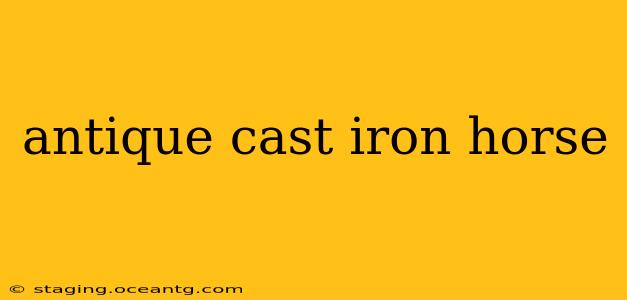Cast iron horses, especially antique ones, hold a special charm for collectors and enthusiasts. Their enduring strength, intricate details, and nostalgic appeal make them highly sought-after items. This guide explores the world of antique cast iron horses, offering insights into their history, identification, care, and value.
What Makes Antique Cast Iron Horses Unique?
Antique cast iron horses are more than just decorative pieces; they represent a bygone era of craftsmanship and industrial artistry. Unlike mass-produced items of today, many antique pieces were created using intricate molds and detailed hand-finishing. This often results in subtle variations between individual pieces, adding to their unique character and collectability. The materials used, including the iron itself and the original paint (if present), also contribute to their historical significance.
How Can I Identify an Antique Cast Iron Horse?
Identifying a truly antique cast iron horse requires a keen eye and some knowledge. Several key factors can help distinguish genuine antiques from newer reproductions:
- Mold Marks: Examine the piece closely for imperfections or mold marks. These are often more pronounced in older pieces due to less refined casting techniques.
- Patina: Authentic antique cast iron horses often display a natural patina, a layer of surface discoloration caused by age and oxidation. This can range from subtle darkening to a rich, rusty brown. A perfectly uniform finish might indicate a newer piece.
- Weight: Cast iron is heavy. A surprisingly lightweight piece might raise suspicion.
- Markings: Look for maker's marks, dates, or other identifying stamps cast into the iron. These can provide valuable clues about the origin and age of the horse.
- Paint: Original paint is rare and highly valuable. Look for signs of age, chipping, flaking, and variations in color that are consistent with the passage of time.
What are the Different Types of Antique Cast Iron Horses?
Antique cast iron horses come in a wide variety of styles, sizes, and purposes. Some common types include:
- Bank Horses: These smaller horses often featured a slot for coins, making them popular children's banks.
- Paperweights: Heavier, more ornate horses designed as decorative paperweights.
- Hitching Posts: Larger, sturdy horses used as decorative hitching posts outside homes and businesses.
- Garden Ornaments: Smaller horses designed for outdoor garden displays.
- Mechanical Horses: More complex pieces incorporating moving parts, such as rocking or nodding heads (often later reproductions).
How Much Are Antique Cast Iron Horses Worth?
The value of an antique cast iron horse varies significantly based on several factors, including:
- Rarity: Unusual styles, maker's marks, and excellent condition all increase value.
- Condition: The level of damage, paint preservation, and overall completeness greatly influence the price.
- Size: Larger horses generally command higher prices.
- Demand: Current market demand for specific types or styles of cast iron horses can impact their value.
How Should I Care for My Antique Cast Iron Horse?
Proper care is crucial for preserving the value and beauty of your antique cast iron horse. Avoid harsh cleaning methods and abrasive materials. A soft cloth and mild soap solution are usually sufficient for cleaning. If your horse shows signs of rust, consult a professional conservator for advice on appropriate treatment. Store your piece in a dry environment to prevent further rust formation.
What are some common myths about antique cast iron horses?
Myth: All antique cast iron horses are valuable. Reality: Value depends on several factors, including rarity, condition, and maker. Many common pieces are readily available and not highly valuable.
Where can I find antique cast iron horses for sale?
Antique cast iron horses can be found at antique shops, flea markets, online auction sites, and estate sales. Always inspect carefully before purchasing and be wary of reproductions.
How can I tell if my cast iron horse is a reproduction?
Reproductions often lack the natural patina and subtle imperfections found in antiques. They might also have a more uniform finish and less detailed molding. Look for maker's marks that could help authenticate its age.
This guide provides a comprehensive overview of the world of antique cast iron horses. With careful research and a discerning eye, you can add a piece of history and artistry to your collection. Remember to always consult experts when in doubt about authenticity or care.
